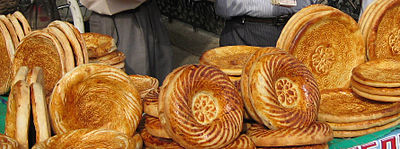- Tajik cuisine
-
Tajik cuisine, the traditional cuisine of Tajikistan, has much in common with Iranian, Afghan and Uzbek cuisines. Plov (Tajik: палав, palav, Uzbek: palov), also called osh (Tajik: ош), is the national dish in Tajikistan, as in other countries in the region. Green tea is the national drink. Traditional Tajik meals start with a spread of dried fruit, nuts, halwa, and other sweets arrayed on the table in small dishes, and then progress to soup and meat, before finishing with plov.
Contents
Common foods and dishes
Palav or osh, generically known as plov, is a rice dish made with shredded yellow turnip or carrot and pieces of meat, all fried together in vegetable oil or mutton fat in a special qazan (a wok-shaped cauldron) over an open flame. The meat is cubed, the carrots are chopped finely into long strips, and the rice is colored yellow or orange by the frying carrots and the oil. The dish is eaten communally from a single large plate placed at the center of the table, but the old way of eating it with one's hands is no longer practiced.
A traditional dish that is still eaten with hands from a communal plate is qurutob (Tajik: қурутоб), whose name describes the preparation method: qurut (Tajik: қурут, dried balls of salty cheese) is dissolved in water (Tajik: об, ob) and the liquid is poured over strips of а thin flaky flatbread (patyr or fatir, Tajik: фатир, or more accurately фатир равғанӣ, fatir ravghani, i.e., fatir made with butter or tallow for flakiness). Before serving the dish is topped with onions fried in oil until golden and other fried vegetables. No meat is added. Qurotob is considered the national dish.
Meals are usually served with non (Tajik: нон), flatbread found throughout Central Asia. If a Tajik has food but not non, he will say he is out of food. If non is dropped on the ground, people will put it up on a high ledge for beggars or birds. Legend holds that one is not supposed to put non upside down because this will bring bad luck. The same holds true if anything is put on top of the non, unless it is another piece of non.
Traditional Tajik soups include mainly meat and vegetable soups (such as shurbo and piti) and meat soups with noodles (such as laghmon and ugro). Other dishes shared regionally, either as fast food or as an appetizer, include mantu (steamed meat dumplings), tushbera (pelmeni), sambusa (a triangular pasty with a meat and onion stuffing, baked in a tandoor oven), and belyash (pl. belyashi, Tajik: беляши, deep-fried cakes made of yeast dough and filled with minced meat, similar to pirozhki).
Dairy products
Dairy dishes, usually served as part of the spread of appetizers in a Tajik meal and scooped with pieces of flatbread, include chaka (a sour milk preparation), thick yoghurt, and kaymak (high-fat clotted cream). Qurut balls may be served as a snack or an accompaniment to cold beverages. Although not a traditional Tajik drink, kefir, a drinking yogurt, is often served with breakfast.
Summer produce
In the summer, Tajikistan is abundant in produce and fruit: its grapes and melons were famous throughout the former Soviet Union. The bazaars also sell pomegranates, apricots, plums, peaches, apples, pears, figs and persimmons.
Beverages
Tea generally accompanies every meal and is frequently offered between meals as a gesture of hospitality to guests and visitors. It is served hot in a china pot with a lid and is drunk without sugar from small saucer-less cups without handles (piala). Because of the universal popularity of tea-drinking, the choykhona or teahouse is the most common gathering place in Tajikistan, and is similar to the Western-style coffee house.
See also

Food portal References
- (Russian) Tajik Cooking, Irfon Publ. House, Dushanbe, 1991
- (Russian) Vahob Khojiev, Traditional and Modern Tajik Cooking, Irfon Publ. House, Dushanbe, 1990
External links
- Laghman, recipe and photos (Russian)
- Belyashi in Tajik cuisine, recipe and photos (Russian)
- Food and traditions of Tajikistan
- Tajik dining
- Tajikistan cuisine on wikia.com
- Tajik culinary recipes and photos in English
- Colorado Tajikistanians, recipes in English
- Welcome to Tajikistan
Asian cuisine Sovereign
states- Afghanistan
- Armenia
- Azerbaijan
- Bahrain
- Bangladesh
- Bhutan
- Brunei
- Burma (Myanmar)
- Cambodia
- People's Republic of China
- Cyprus
- East Timor (Timor-Leste)
- Egypt
- Georgia
- India
- Indonesia
- Iran
- Iraq
- Israel
- Japan
- Jordan
- Kazakhstan
- North Korea
- South Korea
- Kuwait
- Kyrgyzstan
- Laos
- Lebanon
- Malaysia
- Maldives
- Mongolia
- Nepal
- Oman
- Pakistan
- Philippines
- Qatar
- Russia
- Saudi Arabia
- Singapore
- Sri Lanka
- Syria
- Tajikistan
- Thailand
- Turkey
- Turkmenistan
- United Arab Emirates
- Uzbekistan
- Vietnam
- Yemen
States with limited
recognition- Abkhazia
- Nagorno-Karabakh
- Northern Cyprus
- Palestine
- Republic of China (Taiwan)
- South Ossetia
Dependencies and
other territoriesCategories:
Wikimedia Foundation. 2010.




